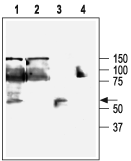Overview
- Peptide RQVRLKHRKLREQV(C), corresponding to amino acid residues 350-363 of rat KCNN4 (Accession Q9QYW1). Intracellular, C-terminal part.

 Western blot analysis of KCa3.1-transfected HEK-293 (lanes 1 and 3) and Human K562 chronic myelogenous leukemia (lanes 2 and 4) cells:1,2. Anti-KCNN4 (KCa3.1, SK4) Antibody (#APC-064), (1:200).
Western blot analysis of KCa3.1-transfected HEK-293 (lanes 1 and 3) and Human K562 chronic myelogenous leukemia (lanes 2 and 4) cells:1,2. Anti-KCNN4 (KCa3.1, SK4) Antibody (#APC-064), (1:200).
3,4. Anti-KCNN4 (KCa3.1, SK4) Antibody, preincubated with KCNN4/KCa3.1 Blocking Peptide (#BLP-PC064).
- Human bronchial epithelial NuLi cells (1:100) (Klein, H. et al. (2009) Am. J. Physiol. Cell Physiol. 296, C285.).
- Rat mesenteric artery parafin-embedded sections (Hilgers, R.H. et al. (2010) J. Pharmacol. Exp. Ther. 333, 210.).
- Normal rat cholangiocytes (NRC) (1:200) (Dutta, A.K. et al. (2009) Am. J. Physiol. Gastrointest. Liver Physiol. 297, G1009.).
- Ghanshani, S. et al. (2000) J. Biol. Chem. 275, 37137.
- Hoffman, J.F. et al. (2003) Proc. Natl. Acad. Sci. U.S.A. 100, 7366.
KCa3.1 (KCNN4, SK4) is a member of the Ca2+ activated K+ channel family that shares the characteristic of being activated by intracellular Ca2+. The channel has an intermediate conductance, is voltage insensitive and is activated by Ca2+ in the submicromolar range. The channel has a similar topology to that of KV channels, that is, six transmembrane domains and intracellular N- and C-termini.
KCa3.1 is widely expressed in epithelial, endothelial and cells of hematopoietic origin. In erythrocytes (red blood cells) it has been identified as the molecular correlate of the so-called Gardos channel.
The functional role of the channel is to set the cell membrane potential at negative values so as to aid in the electrochemical transport of other ions such as Cl- and Ca2+. Indeed, KCa3.1 has a key role in sustaining the Ca2+ influx in activated T lymphocytes and in regulating Cl- secretion from colon epithelium. Therefore, specific blockers of the KCa3.1 channel have been proposed for the treatment of several diseases including autoimmune diseases, secretory diarrhea and sickle cell anemia.
Application key:
Species reactivity key:
Anti-KCNN4 (KCa3.1, SK4) Antibody (#APC-064) is a highly specific antibody directed against an epitope of the rat protein. The antibody can be used in western blot analysis, immunocytochemistry, immunohistochemistry, and immunoprecipitation applications. It has been designed to recognize KCNN4 from human, rat, and mouse samples.
Applications
Citations
- Human airway epithelial cfbe41o cells (1:300).
Klein, H. et al. (2016) PLoS ONE 11, e0153665.
- Human chorionic plate arterial smooth muscle cell sections (8 µg/ml).
Brereton, M.F. et al. (2013) PLoS ONE 8, e57451. - Rat mesenteric artery parafin-embedded sections.
Hilgers, R.H. et al. (2010) J. Pharmacol. Exp. Ther. 333, 210.
- Human chorionic plate arterial smooth muscle cells (10 µg/ml).
Brereton, M.F. et al. (2013) PLoS ONE 8, e57451. - Normal rat cholangiocytes (NRC) (1:200).
Dutta, A.K. et al. (2009) Am. J. Physiol. Gastrointest. Liver Physiol. 297, G1009.
- Kirby, B.S. et al. (2013) PLoS ONE 8, e54849.
- Bagher, P. et al. (2012) Proc. Natl. Acad. Sci. U.S.A. 109, 18174.
- Bouhy, D. et al. (2011) J. Neurosci. 31, 16298.
- Longden, T.A. et al. (2011) Br. J. Pharmacol 164, 922.
- Ohya, S. et al. (2011) J. Biol. Chem. 286, 16940.
- Su, X.L. et al. (2011) J. Mol. Cell. Cardiol. 51, 51.
- Earley, S. et al. (2009) Circ. Res. 104, 987.
- Hirota, C.L. et al. (2009) Br. J. Pharmacol. 156, 1085.
- Feng, J. et al. (2008) Circulation 118, S46.
- Lauf, P.K. et al. (2008) Am. J. Physiol. Cell Physiol. 294, C820.
- Trinh, N.T. et al. (2008) Am. J. Physiol. Lung Cell Mol. Physiol. 295, L866.
- Kaushal, V. et al. (2007) J. Neurosci. 27, 234.
- Dong, H. et al. (2006) Am. J. Physiol. Gastrointest. Liver Physiol. 291, G1120.
- McNeish, A.J. et al. (2006) Stroke 37, 1277.
- Sandow, S.L. et al. (2006) J. Anat. 209, 689.
- Srivastava, S. et al. (2006) Mol. Cell 24, 665.
- Ubels, J.L. et al. (2006) Invest. Ophtalmol. Vis. Sci. 47, 1876.
